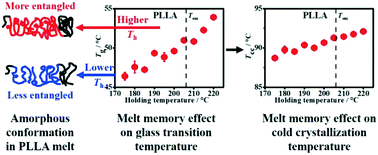Memory effects on crystallization behaviours of poly(l-lactic acid) revisited†
Abstract
Memory effects play an important role in understanding polymer crystallization, especially for self-seeding or self-nucleation of polymer crystallization. Amorphous poly(L-lactic acid) (PLLA) was prepared via quenching after holding at various temperatures. Melt structure and cold crystallization behaviour of PLLA were explored by WAXD, DSC, and FTIR. Both isothermal and non-isothermal cold crystallization behaviours of PLLA show obvious melting memory effects. WAXD profiles and FTIR spectrums indicate that various conformations of the prepared amorphous samples can be distinguished. Fewer entanglements of polymer melt may promote molecular chain motions when holding at lower temperatures and facilitate the subsequent crystallization. The melt memory effect plays a role as “self-plasticization” rather than “self-nucleation”. Real-time FTIR implies the amorphous conformational differences originate from the fresh formed melt structure more than the possibly retained crystal structure. The melt memory effect is a memory of temperature-related dynamic competition of the chain conformations developed in the melting process and the self-nucleated melt is in the metastable heterogeneous state, which may be the origin of the unerased melt memory effect above the equilibrium melting point.



 Please wait while we load your content...
Please wait while we load your content...